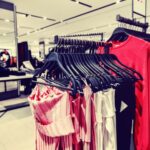The 1950s was an era of fashion revolution. Post-World War II, the world was ready to shake off the austerity of the 1940s and embrace a decade of bold, colorful, and elegant fashion statements. From the rise of the hourglass silhouette to the influence of Hollywood, 50s fashion left an indelible mark on the fashion world, and its influence can still be seen today.
In this article, we’ll dive deep into the various styles, trends, and iconic fashion figures that made 50s fashion so unique. Whether you’re a vintage enthusiast or simply curious about the fashion of the time, this comprehensive guide will take you on a journey back to the fabulous fifties!
The Hourglass Silhouette: Defining the 50s Fashion
When you think of 50s fashion, the hourglass figure immediately comes to mind. Designers like Christian Dior were at the forefront of creating this timeless look. After the boxy, masculine styles of wartime, Dior introduced the “New Look” in 1947, which featured fitted jackets, cinched waists, and full skirts. By the 1950s, this hourglass silhouette had become synonymous with femininity and elegance.
Key Elements of the Hourglass Look:
- Cinched Waist: The waist was pulled in tightly, often with the help of girdles or belts.
- Full Skirts: These skirts flared out dramatically, creating volume and movement.
- Fitted Bodices: Tops were snug to emphasize the natural curves of the body.
This look wasn’t just a passing trend—it represented a shift in societal norms. Women were reclaiming their femininity, and the clothes they wore helped express this newfound freedom.
Hollywood’s Influence on 50s Fashion
Hollywood played a massive role in shaping the fashion of the 1950s. Stars like Marilyn Monroe, Grace Kelly, and Audrey Hepburn became fashion icons, and women everywhere sought to emulate their glamorous styles. The silver screen wasn’t just a source of entertainment; it was a runway of the latest fashion trends.
Iconic Hollywood Styles:
- Marilyn Monroe: Known for her hourglass figure, Marilyn popularized the pencil skirt and plunging necklines.
- Grace Kelly: The epitome of elegance, Grace favored simple, classic silhouettes, often accessorized with pearls.
- Audrey Hepburn: Her boyish figure and chic, minimalist style, especially in movies like Sabrina and Breakfast at Tiffany’s, introduced a more relaxed and modern take on fashion.
These stars weren’t just wearing clothes—they were setting trends. The influence of Hollywood was so pervasive that even average women in small towns aspired to recreate these looks.
Fabrics and Colors: Bold, Bright, and Beautiful
The 50s were all about experimenting with colors and fabrics that felt luxurious after the drab war years. Designers embraced new synthetic fabrics like nylon, polyester, and acrylic, which allowed for more affordable and durable clothing. These new materials became a staple in everyday wardrobes.
Popular Fabrics of the 50s:
- Nylon: Used primarily in undergarments and stockings.
- Polyester: Durable and wrinkle-resistant, making it ideal for dresses and blouses.
- Acrylic: Often used in knitwear, adding warmth without the bulk of wool.
The color palette of the 50s was just as bold as the fabrics themselves. Pastels, polka dots, and checks were all the rage, but bright, eye-popping hues like red, turquoise, and yellow also made frequent appearances. Women weren’t afraid to stand out, and their clothing reflected that.
Men’s Fashion: Sharp Suits and Rock ‘n’ Roll Rebels
While 50s fashion is often associated with women, men’s fashion was equally iconic. The decade saw a divide between traditional, sharp suits and the rebellious styles inspired by the rise of rock ‘n’ roll.
Traditional Men’s Wear:
Men of the 50s were expected to look sharp. Double-breasted suits, fedoras, and pocket squares were essential elements of a well-dressed man’s wardrobe. The silhouette was clean and tailored, with narrow lapels and fitted jackets.
The Rebel Look:
On the other hand, the youth were drawn to the rebellious styles of stars like Elvis Presley and James Dean. Leather jackets, white T-shirts, and denim jeans became the uniform of the disaffected youth, signaling a shift in fashion for younger generations.
Accessories: Completing the Look
No 50s outfit was complete without the right accessories. Hats, gloves, and statement jewelry were all essential parts of a woman’s wardrobe. Meanwhile, men continued to don fedoras and carried pocket watches as a nod to traditional masculinity.
Must-Have Accessories:
- Gloves: Worn by women for both day and evening wear, gloves added an extra touch of elegance.
- Hats: From pillbox hats to wide-brimmed sun hats, no outfit was complete without one.
- Pearls: A classic choice for women, pearl necklaces were the go-to jewelry for the decade.
For men, accessories like fedoras and cufflinks remained a staple. The 50s were all about looking polished and put-together, and the right accessories helped achieve that goal.
50s Fashion Icons: Who Led the Style Revolution?
Several fashion icons helped define 50s fashion. Whether through movies, music, or their personal style, these figures influenced millions.
Marilyn Monroe
As one of the most recognizable figures of the 1950s, Monroe’s style was the epitome of feminine allure. She popularized form-fitting dresses, red lipstick, and platinum blonde curls.
James Dean
The ultimate symbol of rebellious youth, Dean’s leather jacket and jeans became the uniform for young men challenging the status quo.
Audrey Hepburn
Her timeless elegance, especially in films like Roman Holiday and Sabrina, made her a fashion icon. Hepburn’s simple yet chic style, including her famous little black dress, became an enduring fashion statement.
FAQs on 50s Fashion
Q: What were the most popular fabrics in 50s fashion?
A: Synthetic fabrics like nylon, polyester, and acrylic were popular in the 50s due to their durability and affordability.
Q: How did Hollywood influence 50s fashion?
A: Hollywood stars like Marilyn Monroe, Grace Kelly, and Audrey Hepburn set major fashion trends that women around the world sought to emulate.
Q: What was the defining silhouette of 50s fashion?
A: The hourglass silhouette, characterized by a cinched waist and full skirt, was the defining look of the 50s.
Q: What accessories were popular in the 1950s?
A: Hats, gloves, pearls, and leather handbags were all popular accessories that completed a polished look for women. For men, fedoras and cufflinks were must-haves.
Conclusion: The Enduring Legacy of 50s Fashion
Even decades later, 50s fashion continues to influence designers and fashion enthusiasts alike. Whether it’s the hourglass silhouette, the timeless elegance of Hollywood stars, or the rebellious edge of rock ‘n’ roll, the 50s were a decade that redefined style in a big way. For anyone looking to capture the essence of this iconic era, understanding the fashion of the 1950s is key.
Authoritative Sources
- Dior’s “New Look” (https://www.vam.ac.uk/articles/the-new-look)
- 1950s Fashion History (https://www.fashion-era.com/1950s_fashion.htm)
- Hollywood Influence on Fashion (https://www.britannica.com/topic/fashion-industry







